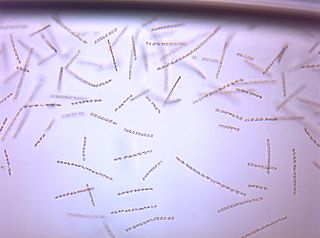
The lazuli bunting is a North American songbird named for the gemstone lapis lazuli.

Oscillatoria is a genus of filamentous cyanobacterium which is often found in freshwater environments, such as hot springs, and appears blue-green. Its name refers to the oscillating motion of its filaments as they slide against each other to position the colony facing a light source. Oscillatoria reproduces by fragmentation, facilitated by dead cells which separate a filament into separate sections, or hormogonia, which then grow. Oscillatoria uses photosynthesis to survive and reproduce. Each filament of oscillatoria consists of trichome which is made up of rows of cells. The tip of the trichome oscillates like a pendulum. In reproduction, it takes place by vegetative means only. Usually the filament breaks into a number of fragments called hormogonia. Each hormogonium consist of one or more cells and grow into a filament by cell division in one direction.

Chaetoceros is probably the largest genus of marine planktonic diatoms with approximately 400 species described, although many of these descriptions are no longer valid. It is often very difficult to distinguish between different Chaetoceros species. Several attempts have been made to restructure this large genus into subgenera and this work is still in progress. However, most of the effort to describe species has been focused in boreal areas, and the genus is cosmopolitan, so there are probably many tropical species still undescribed. Some species are known from the fossil record, from the Quaternary of Sweden. It is the type genus of its family.
Craticula is a genus of diatom that lies on or in the top layers of sediments in the freshwater to brackish water environments it inhabits. In addition to frustule morphology the genus differs from closely related species by its sexual reproduction and movement in response to light.

Bacillariaceae is a family of diatoms in the phylum Heterokontophyta, the only family in the order Bacillariales. Some species of genera such as Nitzchia are found in halophilic environments; for example, in the seasonally flooded Makgadikgadi Pans in Botswana.

Actinocyclus normanii is a microalga, a species of planktonic centric diatom. It is a marine species that is also found in brackish and eutrophic fresh water. It is considered an invasive species in the United States.
Ernst Johann Lemmermann was a German botanist who specialized in the field of phycology.
Stauroneis is a genus of diatoms (Bacillariophyta) with species that occur in fresh and marine water.
Eucocconeis is a genus of diatoms belonging to the family Achnanthidiaceae.
Karayevia is a genus of diatom belonging to the family Achnanthidiaceae.
Kolbesia is a genus of algae belonging to the family Achnanthidiaceae.
Cosmioneis is a genus of diatoms belonging to the family Cosmioneidaceae.
Gomphocymbella is a genus of diatoms belonging to the family Cymbellaceae.
Martyana is a genus of diatoms belonging to the family Fragilariaceae.




